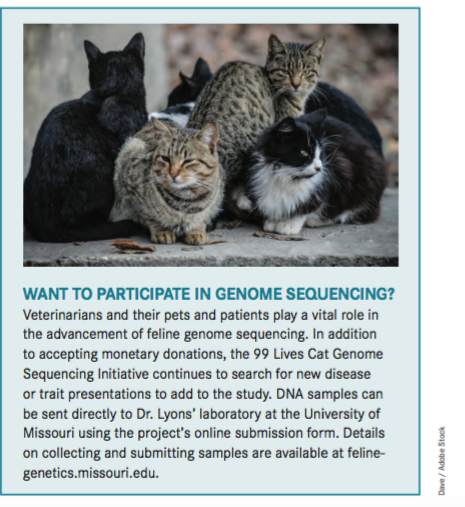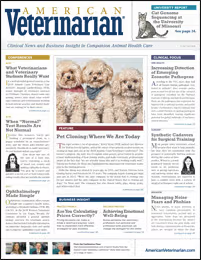99 Lives Cat Genome Sequencing Initiative
In the world of genetics, cats have historically been left behind. The University of Missouri College of Veterinary Medicine is helping them claw their way to the top.
In 1990, when the Human Genome Project got underway in the United States, it struck many as a far-fetched concept pulled from a science fiction novel. Could scientists really map all the locations of every gene of the human species? Not only was the answer yes, but the genome project also opened new, as yet unimaginable possibilities in the way doctors approached disease detection, particularly in the field of molecular medicine.
Fast-forward a decade and the genomes of the human, mouse, and rat were deemed nearly complete. The question then became: What’s next? Ultimately, the National Institutes of Health organized a commission to decide what species would be analyzed, and the dog prevailed. Cats weren’t cast aside entirely, however—or at least not in the eyes of a few passionate geneticists.
Led by Leslie Lyons, PhD, Gilbreath-McLorn Endowed Professor of Comparative Medicine at the University of Missouri College of Veterinary Medicine in Columbia, the 99 Lives Cat Genome Sequencing Initiative is a public effort to uncover genetic variations in cats and improve not just feline but also human health. Its 5 overarching goals:
- Improve coverage of the cat genome.
- Improve future assemblies of the cat genome.
- Identify normal and abnormal genetic variations.
- Identify causative mutations for specific health concerns in cats.
- Allow veterinary hospitals to provide individual genome sequencing for cats.
“The 99 Lives Cat Genome Sequencing Initiative is something we developed at the University of Missouri to try to put all of the people interested in cat health and genetics into a working group that would be very collaborative and supportive,” Dr. Lyons said. “I was able to watch how human medicine and how dogs and other species were developing their genome projects and learn from them. We might not be the first do it, but we could see the good things and the bad things that occurred, and we could tailor our genome project so that we’re more efficient.”
WHAT STANDS TO BE GAINED?
Just as in human medicine, mapping the cat genome provides the opportunity for geneticists to detect and analyze the mutations that make cats unique.
“Every time an individual is born, there’s a chance for new mutations to occur,” Dr. Lyons said. “We tend not to use the word mutation anymore. We say ‘DNA variant,’ but that variation is good. It makes us healthy; it makes us fight off infectious diseases—so we want a lot of genetic variations. But every once in a while, DNA variants do something bad. And so with every baby born, there is about a 1 in 100 chance it has some genetic abnormality. So there'd be no reason why a genetic issue would not be present in 1 out of every 100 cats, dogs, and horses, which are mammals, too."
Some of the specific research being conducted at Dr. Lyons' Feline Genetics and Comparative Medicine Laboratory includes studies to identify the DNA variants that cause various neurologic diseases, susceptibilities to diseases such as cytauxzoonosis, feline orofacial pain syndrome, and dwarfism in the Munchkin breed.
As genetic sequencing continues to advance, current capabilities are considered particularly strong. At least 100 tests for cats and many hundreds for dogs are available, including the ability to whole-genome sequence the entire genome, according to Dr. Lyons. “If we don’t know of a particular mutation that we’re interested in, we can go find it by doing the whole-genome sequencing, which has really decreased in cost because of the advances in human medicine,” she said. “We applied all of those advances to cats and dogs, as well.”
From a One Health perspective, using the developments acquired from human genome sequencing to shine a light onto the feline genome offers the potential to better understand diseases that affect humans and cats alike, including kidney disease, diabetes, obesity, and heart disease.
99 CATS AND COUNTING
When launched, the initiative’s objective was to collect the genome sequences of 99 cats. With the help of investigators and universities from around the world— including Iowa State University; the University of California, Davis; Cornell University; and as far away as Japan, Australia, and New Zealand—the initiative has surpassed its goal and keeps progressing. “Now we have nearly 200 cat genomes that are all done the same way, all of very high quality, and they act as a reference and very good public data set that anyone can use,” Dr. Lyons said.
THE BENEFIT TO VETERINARY MEDICINE
In the typical clinical setting, genome sequencing patients is not yet commonplace, but that doesn’t mean the science can’t be applied. With the public data set created by the 99 Lives Initiative, a veterinarian could essentially genome sequence a feline patient and compare the individual DNA variants with the DNA of 200 other cats. “[Those 200] probably don’t have the variant that's interesting in your patient, and so you can quite quickly eliminate all the DNA variation that's good and find the bad thing that's in your patien that you want to try to address your health care plan toward."
All the published DNA variants can be obtained and the entire genome sequencing downloaded through the National Center for Biotechnology Information, which is hosted by the National Institutes of Health. Sequencing the genome of just 1 cat opens access to the group and all the data, even prior to publication.
“An individual veterinarian probably doesn’t want to do that; they don’t have the capability,” Dr. Lyons noted. “They do want to submit the sample, but then they want to work with some type of genetics team— and that can be teams from all over the world—to analyze the data. Bioinformatics is a very big part of that but is often the part that is lacking in the general veterinary practice.”
However, a collaborator can work with the veterinarian who has collected a DNA sample to find the genetic mutation that may uncover why a cat presents with certain signs or developed a particular disease.
“So, I’ll collaborate with someone and tell them, ‘The mutation’s in this gene; that makes sense. You should now probably tailor your treatment plan toward this gene and this type of mutation in your patient,’” Dr. Lyons said. "Precision medicine for cats!"

